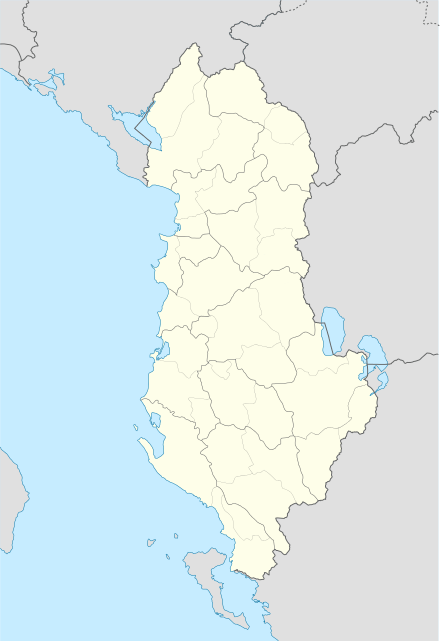Ostren i Vogël
Ostren i Vogël (Bulgarian: Мало Острени/Malo Ostreni, Macedonian: Мало Острени/Malo Ostreni) is a village in the former Ostren Municipality in Dibër County in northeastern Albania. At the 2015 local government reform it became part of the municipality Bulqizë.[1] It is situated within the Gollobordë region.
Ostren i Vogël Мало Острени | |
|---|---|
 Ostren i Vogël | |
| Coordinates: 41°37′11″N 20°28′11″E | |
| Country | |
| County | Dibër |
| Municipality | Bulqizë |
| Municipal unit | Ostren |
| Time zone | UTC+1 (CET) |
| • Summer (DST) | UTC+2 (CEST) |
Demographic history
In an 1878 report, reflecting 1873 statistics, Ostren i Vogël was recorded as having 90 households with 155 Slavic Muslims (Pomaks) and 103 Bulgarian Christians.[2]
In the early 20th century, Ostren i Vogël was a village with a mixed population of Bulgarian Muslims and Bulgarian Christians, according to Bulgarian geographer Vasil Kanchov's statistics. The Muslim population was prevalent, with 400 Bulgarian Muslims reported and 78 Bulgarian Christians.[3] The "La Macédoine et sa Population Chrétienne" survey by Dimitar Mishev concluded that the Christian population in Malo-Ostreni in 1905 was composed of 120 Bulgarian Exarchists.[4]
The village of Ostren i Vogël is inhabited by an Albanian population which dominates demographically in the village.[5] Other inhabitants of Ostren i Vogël are speakers of a south Slavic language[6] (Macedonian) of whom in the village traditionally consist of a mixed Slavic Orthodox Christian (Macedonian) and Muslim (Torbeš) population.[5]
References
- Law nr. 115/2014 Archived 2015-09-24 at the Wayback Machine
- „Македония и Одринско. Статистика на населението от 1873 г.“ Македонски научен институт, София, 1995, стр. 172-173.
- Кънчов, Васил. „Македония. Етнография и статистика“. София, 1900, стр.262. (Kanchov, Vasil. Macedonia — ethnography and statistics Sofia, 1900, p. 262).
- D.M.Brancoff. "La Macédoine et sa Population Chrétienne". Paris, 1905, р. 152-153. (online at Archive.org)
- Vidoeski, Božidar (1998). Dijalektite na makedonskiot jazik. Vol. 1. Makedonska akademija na naukite i umetnostite. ISBN 9789989649509.CS1 maint: ref=harv (link) p. 214. "Заедно со македонско христијанско население Торбеши живеат и во селата: Могорче, Требиште, Велебрдо, Ростуше, Јанче, Долно Косоврасти (во Река), Горенци, Житинени (во Жупа), Џепиште, Себишта, Пасинки, Големо и Мало Острени, Требишта, (во Голо Брдо),"; p 339. "Во повеќето од спомнативе села живее население - со македонски и со албански мачин јазик. Албанското население доминира во северните голобрдски села Себишта, Пасинки, Врмница, Големо и Мало Острени). Селата: Лешничани, Требиште, Српетово, Торбач, Љуболези, Владимирица и Тучепи се населени со Македонски муслимани (Торбеши), а во Себишта, Требиште, Г. и М. Острени живее мешано население - православни и Торбеши."
- Steinke, Klaus; Ylli, Xhelal (2008). Die slavischen Minderheiten in Albanien (SMA): Golloborda - Herbel - Kërçishti i Epërm. Teil 2. Munich: Verlag Otto Sagner. p. 10. ISBN 9783866880351.CS1 maint: ref=harv (link) "Heute umfaßt das Gebiet von Golloborda in Albanien 22 Dörfer, die verwaltungstechnisch auf drei verschiedene Gemeinden aufgeteilt sind: 1. Die Gemeinde Ostren besteht aus dreizehn Dörfern, und Südslavisch wird in den folgenden neun Dörfern gesprochen: Ostreni i Madh (Golemo Ostreni/Ostreni Golemo), Kojavec (Kojovci), Lejçan Lešničani), Lladomerica (Ladomerica/Ladimerica/Vlademerica), Ostreni i Vogël (Malo Ostreni/Malastreni/Ostreni Malo), Orzhanova (Oržanova), Radovesh (Radoveš/Radoeš/Radoešt), Tuçep (Tučepi) und Pasinka (Pasinki). 2. Die Gemeinde von Trebisht umfaßt die vier Dörfer Trebisht (Trebišta), Gjinovec (G'inovec/G'inec), Klenja (Klen'e) und Vërnica (Vărnica), und in allen wird Südslavisch gesprochen. 3. Die übrigen Dörfer von Golloborda gehören zur Gemeinde Stebleva, und zwar Stebleva, Zabzun, Borova, Sebisht, Llanga. Südslavisch wird in Stebleva (Steblo) sowie von drei Familien in Sebisht (Sebišta) gesprochen. Wie aus den bisherigen Ausführungen und den Erhebungen vor Ort hervorgeht, gibt es nur noch in fünfzehn der insgesamt Dörfer, die heute zu Golloborda gehören, slavophone Einwohner. Die Zahl der Dörfer in Golloborda wird manchmal auch mit 24 angegeben. Dann zählt man die Viertel des Dorfes Trebisht, und zwar Trebisht-Bala, Trebisht-Çelebia und Trebisht-Muçina separat."
